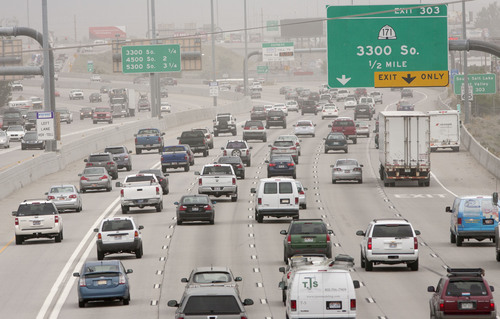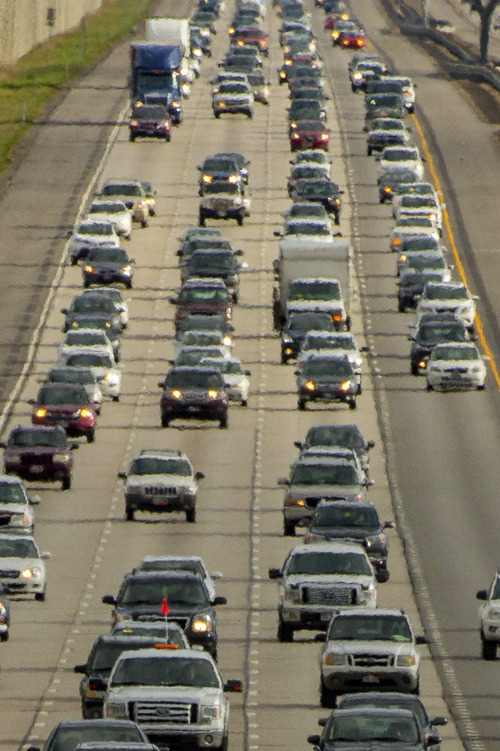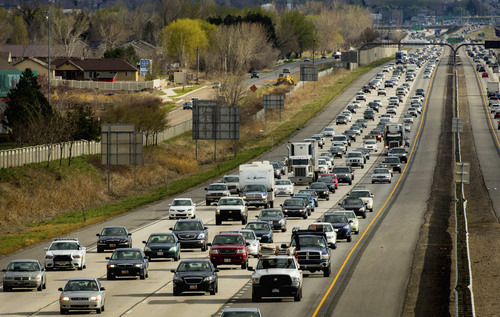This is an archived article that was published on sltrib.com in 2014, and information in the article may be outdated. It is provided only for personal research purposes and may not be reprinted.
A new study says traffic congestion in the Salt Lake City area isn't all that bad compared with other large metro areas in the Americas.
It ranks 48th among 63 metro areas with at least 800,000 residents, according to a worldwide study released Wednesday by TomTom, a company that sells in-car electronics that guide drivers from point to point while suggesting routes to avoid current congestion.
Still, Salt Lake City area motorists are delayed 16 minutes for every hour they drive during peak commute times, the study says.
It could be far worse.
In the Americas, Rio de Janeiro had the worst average congestion level of 55 percent, meaning any trip is likely to take 55 percent longer than in a free flowing traffic situation. During the peak evening commute there, congestion levels are 115 percent.
Los Angeles ranked worst in the United States (but was No. 4 in the Americas behind Rio, Mexico City and Sao Paulo). Its average congestion level was 36 percent in 2013, reaching 75 percent during the peak evening commute.
Average congestion in the Salt Lake metro area in 2013 was 14 percent — compared with an average of 20 percent for all large metro areas in the Americas. But Salt Lake's congestion level rises to a high of 33 percent in the peak afternoon commute.
The study says congestion in the Salt Lake City area is about the same as in Memphis, Tenn.; Buffalo, N.Y.; Hartford, Conn.; Oklahoma City; and Columbus, Ohio.
The least-congested large metro area in the Americas is Kansas City. Average congestion there is 9 percent, reaching 23 percent in the evening commute.
The study says Salt Lake City area motorists, with a 30-minute commute, spend 48 hours a year — two full days — stuck in traffic.
It adds that the most-congested single day in 2013 was Dec. 3, when a major snowstorm snarled traffic.
The best weekly commutes during peak periods in the area, the study says, are Friday mornings and Monday evenings. The worst are Monday mornings and Thursday evenings.
The study says congestion is much worse on local roads than on major highways and freeways. It says typical congestion levels on highways is 4 percent, compared with 21 percent on non-highways. It adds that Salt Lake metro congestion was roughly the same as the previous year.
Carlos Braceras, executive director of the Utah Department of Transportation, credits the relatively low congestion to governors and legislators who set up special taxes to fund highway projects specifically designed to increase capacity and reduce traffic jams.
"This is consistent vision" going back "to 1997, when they created the Centennial Highway Program," Braceras said, which funded, among other projects, the Interstate 15 rebuild in Salt Lake County before the 2002 Olympics.
That initiative increased the gasoline tax by 5 cents a gallon. Since then, other sales tax revenue increases also have been earmarked for them, and raised billions to help pay for such upgrades as rebuilding I-15 in Utah County and constructing the new Mountain View Corridor.
Braceras said the current I-15 widening in Davis County and planned freeway improvements in Salt Lake County near the Point of the Mountain next year also are paid for by such funds.
He said Utah legislators "did not want to just say we cannot address congestion. I hear that in other parts of the country ... and they give up."
The Utah Transit Authority also has completed 70 miles of rail lines — TRAX, FrontRunner and streetcar — in the past seven years to steer more commuters away from cars, although the agency has cut some bus service to pay for it.
"I cannot overstate," Braceras said, "how much transit and transit development in this state means."
He noted that planners expect the Wasatch Front's population to double by 2050. Business leaders and mayors have been pushing for more transportation money to handle that growth, and the Legislature is studying proposals on how to raise it. —
Worst traffic congestion in the Americas
1 • Rio de Janeiro, average congestion level: 55 percent; evening peak, 115 percent.
2 • Mexico City, average: 54 percent; evening peak, 89 percent.
3 • Sao Paulo, average: 45 percent; evening peak, 95 percent.
4 • Los Angeles, average, 36 percent; evening peak, 75 percent.
48 • Salt Lake City, average 14 percent; evening peak, 33 percent.
63 (lowest) • Kansas City, average 9 percent; evening peak, 23 percent.
Congestion level is the increase in travel time compared to free-flowing traffic situations.
Source: 2013 TomTom America's Traffic Index







